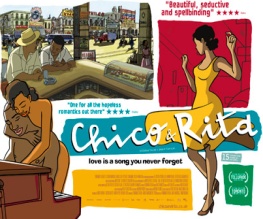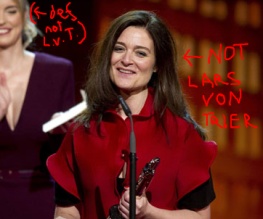Chico & Rita

Chico (Eman Xor Ona) is an old man when he first appears on screen. A vibrant and colourful depiction of Cuba closes in around him as he slowly makes his way through streets that provide a vivid contrast to his quiet air. Strangers call out greetings as he passes them by and Chico responds politely and with reserve. He reaches his tiny dank apartment, enters and pours two glasses of whiskey. He then turns to his radio and softly adjusts frequency, looking for the right one. And then the music starts.
Chico and Rita is a Spanish film that follows the rise and fall of the titular characters as they weave in and out of each other’s lives and the world of jazz. The animated story kicks off as the old Chico listens to his radio, reminiscing about earlier times. The perspective then shifts to years earlier where he is a young piano player, living in Havana in the 1940’s. Confident and yet insecure, he meets the gorgeous singer Rita (Limara Meneses) while out with his friend and manager Ramon (Mario Guerra) at one of the local jazz clubs. They both dazzle each other with their feel for music, and are in each other’s arms by the end of the night.
Unfortunately for the pair, Chico’s girlfriend arrives the next morning and angrily confronts the two; chasing Rita away and scolding Chico. But Ramon, ever the opportunist, persuades Rita to put aside their encounter and join Chico as an act and together they start gaining success. Inevitably the initial spark of romance returns as well and the two start rebuilding their brief tryst into something more as their careers move forward. This becomes the regular format for their encounters and this particular scene is probably the best example of their constant back and forth. What follows from then on is a poetic collection of unspoken words, beautiful music, betrayal and glimpses of the love that exists between Chico and Rita.
Visually, Chico & Rita is exceptional. Uniquely drawn characters and scenery ensure a detectable style and add to the “dancing” pace of the film. Varying – sometimes absurd – colours and tones suggest themes before they are even addressed by the characters. They touch on subjects like the social divide evident between the classes in Havana and New York, while the accentuated range of emotions on display contribute to the understanding of the true feelings involved from each persona. And then there is the music. To say that the film is a musical would perhaps give the wrong impression; there are no “set pieces” where everyone breaks into song but rather sequences where the music is used to drive home exactly what the particular part of the story is trying to convey: from a joyful piece of music to accompany the meeting of old friends or the mournful dirge to comply with the parting of two lovers.
The reason this “musical resonance” truly becomes so effective is because of the lack of translation that occurs when Rita sings. When she begins to sing the first two or three lines are translated, signalling the intent of the song, but then suddenly the subtitles disappear. As a viewer, Spanish or English, the response is quite natural, you stop looking down and focus on her. Rita and what she is singing become the only focus point in the film. As a non-Spanish speaker I couldn’t help but think of the rather fantastic quote from Shawshank Redemption: “I have no idea to this day what [Rita] was singing about. Truth is, I don’t want to know. Some things are best left unsaid. I’d like to think [she] was singing about something so beautiful, it can’t be expressed in words, and makes your heart ache because of it.” So don’t be surprised when the translation stops; it’s done for a reason.
In the end the film does so well in immersing the audience into this world of passion and musical meaning that it’s hard not to be sucked into it. Using memorable visuals and a varied range of jazz music to provoke the intended emotions, it succeeds fantastically as a Latin ballad, or bolero, and makes Chico & Rita a film that should definitely not be missed.








Recent Comments